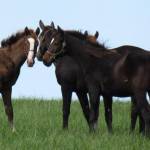Reducing Stereotypic Behaviors in Horses

Some simple management practices might prevent horses from developing stereotypic behaviors, or reduce their frequency once established.
Owners and managers should observe weanlings closely, as researchers have reported that many horses begin cribbing at this stage. If foals are spending a large amount of time in oral activities other than eating, managers might want to reduce the carbohydrates in the diet, switch the concentrate ration from a sweet feed to a pellet, and increase the amount of forage that is offered to the weanling. Antacids might also be helpful.
Exercise has not been shown to have an effect on cribbing in horses, but it might aid in reducing wood-chewing and locomotor stereotypies such as weaving or stall-walking. Moving horses from stall to pasture is recommended to reduce locomotor stereotypies. If pasture is not an option, increasing daily exercise, feeding numerous small meals throughout the day, placing flakes of hay in each corner of the stall to mimic grazing activity, providing toys, and using a foodball or other device to deliver concentrate rations help increase activity in the stalled horse and keep it occupied.
Stalled horses should have visual contact with other horses to reduce development of stereotypic behavior and promote normal feeding behaviors. If visual contact is not available, distractions such as mirrors may help reduce stereotypic behaviors. Managers should observe horses closely for signs of anxiety or stereotypic behaviors when any changes in housing or in neighbors are implemented. Solutions as simple as moving a horse to another stall may greatly influence behavior.
It is probably easier to prevent undesirable behavior in horses than to stop these behaviors once they become habits. Vigilant managers who can identify initial signs of anxiety and stereotypies in horses and who are willing to individualize the care of these horses are the primary protection against horses developing them. Naturalizing the nutrition, housing, and care of the horse to mimic free-ranging conditions as much as possible is the best option for reducing and preventing undesirable behaviors in the horse at the present time.
Read more from Advances in Equine Nutrition IV.
Related reading:








